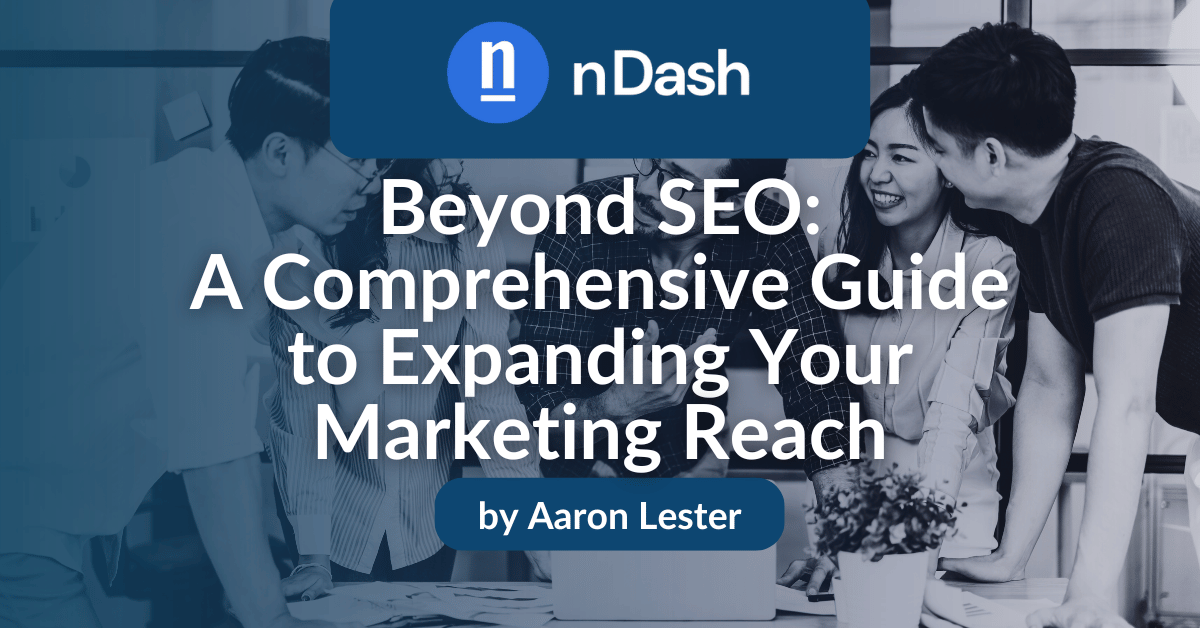If you’ve recently found yourself playing a “spin the wheel” game to get a discount on shampoo, you understand the massive shifts in marketing tactics over the past two and a half decades. These days, content distribution channels evolve at a breakneck pace.
For years, SEO was the only game in town – or at least the most important. “Gaming” Google was part and parcel of the job. But we marketers need to look beyond SEO to captivate our digitally savvy – dare we say jaded – audience.
Understanding Marketing Channels
Marketing channels are the arteries through which businesses connect and engage with customers. In our digital age, traditional arteries such as print, television, and radio coexist with dynamic digital platforms. Digital channels offer unparalleled reach and immediacy.
However, direct channels, including sales teams and retail outlets, establish face-to-face experiences with customers, which is marketing gold. A Harvard Business Review survey found that 95% of respondents consider face-to-face interactions the key to lasting customer relationships. Indirect channels, conversely, leverage intermediaries like wholesalers and distributors to extend market reach. Integrating this range of strategies will enable you to be in it to win it for the long term.
Core Digital Channels
Both traditional and emerging marketing channels offer unique strengths that can boost your digital efforts. These mediums create engaging, real-world experiences that connect with audiences on a deeper level.
Website and Content Creation
We cannot overstate the foundational role of your website and quality content. A well-designed website is the central hub for your brand. It’s where you can offer visitors quality content, such as blog posts, eye-catching videos, and interactive experiences. Prioritizing blogging in your content marketing strategy, for example, is 13 times more likely to see positive ROI, according to Hubspot. What’s more, B2B marketers who blog get 67% more leads than those who don’t, the report states.
Social Media
Social media is no longer the new kid on the block. (Did I just give away my age?) It’s able to give you access to broad audiences and targeted advertising options. Statista reports that in 2022, over 4.59 billion people worldwide were using social media. This number is projected to reach almost six billion by 2027. That’s market-reach material if I’ve ever seen it.
Email Marketing
While it is everybody’s favorite pastime to hate on “spam,” the fact is email works. Campaign Monitor’s 2019 research found that personalized email marketing campaigns generate a median ROI of 122%. Plus, you’d never spam anyway. You know the difference between spam and relevant content delivered to those who want it.
Targeted email campaigns allow you to effectively segment your target audience. You can deliver the right content to the right person at the right time. It helps you nurture relationships with customers over time if you avoid converter-killing inbox-bombarding emails. You can also automate your emails at scale. But again, don’t overschedule if you don’t want your unsubscribe list to blow up.
Video and Podcasting
Nothing captivates, like visual and auditory storytelling. And it has to be said: podcasts are hot. A 2021 report by Wyzowl states that 86% of businesses were using video as part of their marketing mix. Edison Research reports that 41% of Americans aged 12 and older tuned into a podcast during the last month, up from 37% in 2020 and just 32% in 2019. Video and audio allow you to tell your brand story, spotlight your products, and share your expert insights. Auditory and video snippets also play well on social media, expanding reach and audience engagement – sharing, hearting, clapping, and all the rest.
Traditional and Emerging Channels
Traditional and bells-and-whistles digital marketing offers a powerful toolbox. But to truly connect, we need strategic direct and indirect approaches. That means personalized touches like mailers and sales outreach alongside partnerships to amplify your reach.
Traditional Advertising (Print, TV, Billboards)
While digital marketing offers precise targeting and eyeball-grabbing experiences, traditional advertising channels still hold significant sway. In fact, a MarketingSherpa survey found that the top five most trusted advertising formats are all traditional, with 82% of respondents saying they trusted print advertising the most. While 80% trusted television advertising.
Direct mail advertising came in at 76%, and 71% of respondents said radio advertising was their choice when making purchasing decisions. Print, TV, and billboard advertising has broad visibility beyond digital platforms. These old-school but enduring strategies command attention in physical spaces.
By leveraging traditional advertising alongside digital strategy, businesses can reach even those who don’t spend their days scrolling.
Events and Experiential Marketing
Live and virtual events offer opportunities for authentic face-to-face interactions, networking, and experiential experiences. Events create direct engagement with your would-be customers. What’s more, according to a 2023 Bizzabo study, 80.4% of event organizers believe that events are the most critical marketing channel for achieving business goals.
Virtual events are also great opportunities to provide valuable content and even entertainment. They can attract new leads, nurture relationships with existing customers, and generate buzz around your brand. In a report released by vFairs this year, 95.5% of the people surveyed said that virtual events would be a part of their events strategy for the next year.
Influencer and Affiliate Marketing
Influencers are … well … influential. People like them and trust them. By tapping into their uberfan base, some of that trust dust rubs off on your brand. Influencers possess dedicated followings within specific niches or demographics, allowing you direct access to a targeted pool of buyers. These collabs need to be authentic, though.
Your audience is smart. They know Taylor Swift doesn’t obsess over your carburetors. Though, to be fair, she could probably sell more than a few. But seriously, are influencers worth it? You bet. A 2024 benchmark report produced by Influencer Marketing Hub indicates that businesses earn a little over five dollars for every dollar they spend on influencer marketing.
Similar to influencers, affiliates extend your reach by promoting your uncommonly brilliant product to their networks in exchange for a commission. A collaborative approach offers a powerful advantage: it increases brand awareness while simultaneously enhancing consumer trust. Doing so ultimately drives engagement, conversions, and market expansion.
Direct and Indirect Marketing Strategies
Effective marketing isn’t just about choosing platforms. It’s about how we leverage them to reach and resonate with our target audience. Direct engagement personalizes the message, while indirect strategies amplify it through influence. We need to understand which channels best align with our goals, audience, and resources.
Direct Mail and Sales Teams
Combining a personal touch with direct mail and dedicated sales efforts is crucial for blowing up your market reach. A personal touch can tailor your messaging to individual recipients. Additionally, dedicated sales efforts include one-on-one interactions with prospects, enabling businesses to build authentic relationships IRL.
By integrating these approaches, companies can penetrate new markets, nurture leads, and – the reason we’re all here – drive conversions. Oh, and if you’re skeptical about old-school direct mail, consider this: According to Sequel Response, direct mail ROI outperforms all other marketing media, reporting the highest ROI of 161% when sent to house lists. Email-to-house lists have an ROI of 44%.
Partnerships and Joint Ventures
Strategic collaborations and partnerships play are crucial for expanding your reach. These relationships are synergistic. Collabs multiply potency by using shared resources, expertise, and networks. As a result, both you and your partners achieve mutual goals effectively.
Moreover, partnering with established brands lends the one-two punch of credibility and trust. Examples: Peeps x Pepsi. Oscar Mayer x Seoul Mamas Facemask. Because what skin care aficionado doesn’t like bologna on their face?
Choosing the Right Channels for Your Business
Aligning marketing channels with your business goals may be the key to success with these non-SEO-focused strategies. Considering your available resources and your target demographics, you’ll need to balance experimentation with data-driven decision-making.
- Begin by clearly defining business objectives and identifying key performance indicators (KPIs) that align with those goals.
- Develop a comprehensive profile of your target market, including their preferences, behaviors, and preferred online channels. Doing so helps you tailor your marketing efforts for maximum impact.
- Experiment with a mix of channels to reach your audience effectively, considering factors such as budget, time, and personnel constraints.
- Monitor the performance of each channel closely. Gather data on engagement, conversions, and ROI.
- Use this data to refine your approach and prioritize channels that yield the best results.
- Continuously iterate and refine strategies based on insights gained from experimentation.
By combining experimentation with data-driven insights, you can optimize channel selection to reach your target audience and achieve your business objectives effectively.
Integrating New Channels: Your 2024 Strategy
Expanding market reach beyond SEO involves integrating new content distribution channels into your mix. It means experimenting with strategies and making data-driven decisions to engage expansive new audiences effectively.
About the Author
 Aaron is a passionate writer, editor, and content marketer with over 10 years of experience crafting compelling stories. These stories are for brands and their audiences across IT, journalism, and non-profit sectors. Visit his nDash writer profile to see how his expertise can help level up your content strategy: Aaron Lester.
Aaron is a passionate writer, editor, and content marketer with over 10 years of experience crafting compelling stories. These stories are for brands and their audiences across IT, journalism, and non-profit sectors. Visit his nDash writer profile to see how his expertise can help level up your content strategy: Aaron Lester.
